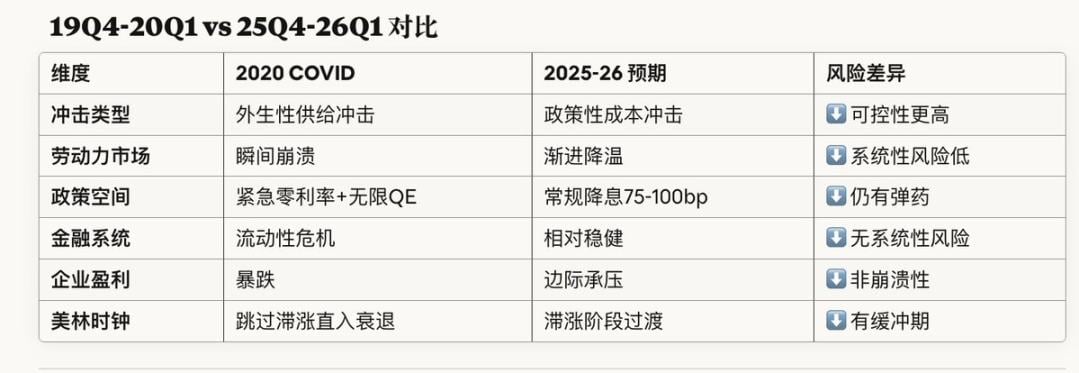Author: NingNing
As of 2025, we have experienced less than four complete four-year cycles. Statistical common sense tells us that any conclusions drawn from a very small statistical sample size (with only three effective sample data points) need to be cautiously verified, rather than simply taken on faith.
In predicting large market cycles with small samples, deriving the comparison of Q4 2025 to Q4 2019 using Bayesian probability methods is more valuable than the four-year cycle theory.
Transforming the comparison of Q4 2025 to Q4 2019 into the Bayesian formula, we have P (Bear Market | Merrill Lynch Clock Stagflation to Recession) = [P(Bear Market) / P(Merrill Lynch Clock Stagflation to Recession)] * (P(Merrill Lynch Clock Stagflation to Recession | Bear Market)
Bayesian Probability Parameter Estimation
P(Bear Market) - Prior Probability
Since 1929: The S&P 500 has experienced 27 bear markets.
Average frequency: once every 3.5 years.
Annual probability: approximately 28.6%.
Quarterly probability (spanning Q4 to Q1): approximately 15-20%.
Conservative estimate: P(Bear Market) ≈ 18%
P(Stagflation → Recession) - Probability of Transition from Merrill Lynch Clock
Historically, the transition probability from "Stagflation → Recession":
1970s Stagflation: ultimately led to three recessions in 1973-74, 1980, and 1981-82.
2000-2001: Tech bubble burst, mild recession.
2007-2008: Financial crisis, deep recession.
2011-2012: Euro debt crisis, not a complete recession (avoided).
2018-2019: Trade war concerns, successful soft landing.
Statistical estimation:
In the past 50 years, there have been about 6 "Stagflation → Recession" scenarios.
Of these, 4 transitioned to recession (66%).
2 soft landings (34%).
Current environment adjustments:
The Federal Reserve is actively cutting interest rates (vs. passive rate hikes in the 1970s).
Labor market resilience (vs. systemic risk in 2008).
Uncertainty in tariff policies.
Global de-dollarization pressure.
Estimate: P(Stagflation → Recession) ≈ 40-50% (taking the median of 45%)
P(Stagflation → Recession | Bear Market) - Likelihood Probability
Under the condition of a bear market, the probability of experiencing "Stagflation → Recession":
Historical classification of bear markets:
Recession-type bear markets (12 instances): 1929, 1937, 1973-74, 1980, 1981-82, 1990, 2000-02, 2007-09, 2020, 2022.
Non-recession-type bear markets (15 instances): other technical adjustments.
Among the 12 recession-type bear markets:
Those that experienced stagflation: 1973-74, 1980, 1981-82, 2007-08 (about 4 instances).
Those that did not experience stagflation: 1929 (deflation), 2020 (pandemic shock), 2022 (pure inflation).
Estimate: P(Stagflation → Recession | Bear Market) ≈ 33%.
Bayesian Calculation
Standard formula:
P(Bear Market | Stagflation → Recession) = P(Stagflation → Recession | Bear Market) × P(Bear Market) / P(Stagflation → Recession)
= 0.33 × 0.18 / 0.45
= 0.0594 / 0.45
= 0.132 = 13.2%.
Scenario Analysis Matrix

Key Difference Analysis: Why is the probability low?

Comprehensive Conclusion
P(25Q4-26Q1 Bear Market) ≈ 15-20%.
Confidence Interval:
Lower limit (optimistic): 12%.
Median (baseline): 17%.
Upper limit (pessimistic): 25%.
Strategy
Tactical defense is needed rather than strategic retreat.
免责声明:本文章仅代表作者个人观点,不代表本平台的立场和观点。本文章仅供信息分享,不构成对任何人的任何投资建议。用户与作者之间的任何争议,与本平台无关。如网页中刊载的文章或图片涉及侵权,请提供相关的权利证明和身份证明发送邮件到support@aicoin.com,本平台相关工作人员将会进行核查。




